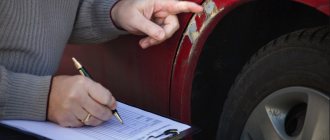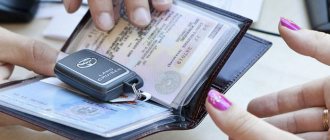Vehicles may be subject to arrest to exclude the possibility of performing registration and formalities with them until the owner repays existing financial debts and executes the relevant court decisions. The purpose of these restrictive measures is to prevent illegal sales, as well as concealment of the car or its destruction. Sometimes they can be supplemented by a ban on the operation of the car with subsequent seizure or transfer to a third party for safekeeping.
The removal of a seizure from a car imposed by bailiffs is carried out in the manner determined for each specific case by current legislation. In any case, the main condition is that the debtor fulfills all existing obligations, including compensation for expenses incurred by third parties during this administrative process. This applies to paid state fees, legal costs and other expenses, the repayment of which is carried out at the expense of the defendant.
How to find out if a car is seized?
Information about restrictive or interim measures taken in relation to a specific vehicle can be obtained online.
You can obtain information about restrictive measures regarding a vehicle for free - on the page https://www.gibdd.ru/check/auto/#wanted (this is the official website of the State Traffic Inspectorate). The tools are simple and clear, the information of interest is displayed with a few mouse clicks in a maximum of a couple of minutes. The check is carried out based on the entered VIN code or body/chassis identification number (these details are available in the vehicle registration documents). You will also need to enter a security code (captcha). Click the "Request Review" link in the "Check for Restrictions" section and the relevant machine details will be displayed on the screen.
You can also check whether it is necessary to remove the arrest from the car by personally contacting any traffic police department. In addition, this information is provided by the department of the Federal Bailiff Service, located at the place of registration of the owner of the vehicle. If there are restrictions regarding the machine, this body is obliged to notify about this, indicating the reasons that became the basis for making the corresponding decision.
If there is information about the place of registration of the car owner and his full name, you can obtain information about the presence/absence of restrictions on the vehicle on the official website of the FSSP at https://fssprus.ru/iss/ip. This contains the most current information, including those that have not yet entered the State Traffic Inspectorate database.
Who can seize a vehicle?
In most cases, vehicles are seized by the Federal Bailiff Service. Customs authorities can also seize the car: this is done in case of non-compliance with customs clearance rules, non-payment of due payments, other mandatory fees, including imposed financial sanctions. In addition, the seizure of vehicles is possible on the initiative of other organizations if there is a corresponding decision of the judicial authority.
In any case, after this it is prohibited to carry out any registration actions with the car: registration/deregistration with the State Traffic Inspectorate, donation, sale, re-registration, etc.
It should be understood that the traffic police does not seize vehicles. Many people confuse this restrictive measure with the forced evacuation of an illegally parked car. This is a common misconception, since in the latter case we are not talking about a ban on registration and other actions (re-registration, purchase/sale, etc.). After paying the fine imposed by the traffic police and, if necessary, paying off other debts (for example, for impound area services), the car can be picked up at any time. As such, the seizure of the car does not take place in this case; it is simply returned to the owner or his legal representative.
Legislative aspect
The bailiff service decides to seize the vehicle if there is a corresponding court verdict. The reason is the owner’s failure to fulfill his financial obligations, including:
- alimony;
- bank loans (this applies not only to the amount of debt, but also to interest due, as well as other obligatory payments to the financial institution);
- fines imposed by the traffic police and other government agencies;
- taxes and mandatory non-tax payments;
- debts for utilities, etc.
After the court issues a decree to seize a vehicle, bailiffs are obliged to inform the owner of the car, as well as the relevant government agencies, about this.
Then, within a month from the date of discovery of the debtor’s property, the bailiff must find a professional appraiser to determine the real value of the seized assets in accordance with current market realities. Current legislation provides for a period of one week to a month to carry out the assessment. No later than 3 days from the moment of receiving information from the appraiser, the bailiff must issue a decision on the assessment.
If the seizure of the vehicle is not removed within the prescribed period, then after evaluation it must be transferred to a specialized organization for sale within 10 days. If the deadlines provided by law are not met, the claimant has the right to appeal the behavior of the bailiffs to their managers or in court.
What information is included in the application?
According to Article 80 of the Federal Law of October 2, 2007 N 229-FZ (as amended on December 27, 2018) “On Enforcement Proceedings”, in order to ensure the fulfillment of the property requirements contained in the writ of execution, the bailiff has the right to seize the debtor’s property . To do this, he must have a decree on seizure.
First of all, penalties are imposed on cash, accounts, securities, and bank cards. It can also be applied to any regular cash payments. But if all of the above is not enough, then a judicial act is issued to seize other property of the defendant. The court indicates what restrictions need to be imposed, and the bailiff seizes the property taking into account these instructions.
If the court indicated only the total value of the property, then its specific composition is left to the discretion of the bailiff. However, you cannot seize a car if the debt is much less than its market value. That is, the seizure of property must be proportionate to the volume of property claims.
The bailiff sends the resolution to prohibit the disposal of the vehicle to the traffic police.
Removing the seizure of a car by bailiffs will mean returning the rights to it to the motorist in full.
The reasons for the arrest depend on who exactly is imposing the restrictive measures. For example, the initiator may be the FSSP. In this case, the car is seized in order to ensure its safety (until the division of property between spouses or until the end of the clarification of the property dispute) or to sell it under the hammer (by paying off the debts of the car owner with the proceeds).
In addition to arrest and confiscation, restrictive measures may be taken - for example, a ban on registration - the car cannot be deregistered. Before the sale, it will be necessary to remove the encumbrance from the bailiffs.
If the arrest is imposed by the customs service, the reason will be incorrect customs clearance.
The approximate terms of arrest are indicated in the act drawn up by the bailiff. Is it possible to remove the seizure from a car before this period expires? It is possible if the debt is fully repaid or the case is closed for other reasons (the defendant filed and won a counter-case, the claimant compromised and withdrew the writ of execution, etc.).
The bailiff, having received evidence that all the prerequisites for lifting the restrictions have been met, issues a decree to lift the sanctions. The car owner can receive this resolution in his hands on the same day. At the same time, the FSSP employee sends the document to the traffic police, where all restrictive measures will be lifted within three days.
We remove restrictions on the car ourselves - is this possible? Maybe. Moreover, active actions will only help return the “iron horse” in a short time. Action algorithm:
- check whether the car is seized (how to find out about this - on the traffic police website through services, including checking the car);
- contact the bailiffs and take a copy of the restriction order;
- appeal the document or fulfill all requirements (for example, pay a debt);
- obtain orders to lift the restriction;
- go with him to the traffic police and write statements, attaching a copy of the resolution to it.
Alternatively, you can wait until the ban is lifted automatically (provided that the sale does not threaten him). The bailiff is obliged to notify the car owner about the lifting of all restrictions.
A seizure is a restriction that can be placed on your car (legal property). This kind of trouble can happen for many reasons. For example, you were deceived and sold a problem car, or you found yourself in the center of events where you became a criminal. Then the court decides to seize the property as security for the claim, etc. But what should a car owner do and is it possible to get rid of the restriction and get his property back? How to do this correctly, according to the letter of the law?
We suggest you read: Taxes under a contract
It's worth distinguishing!
Before solving the problem of lifting the arrest, it is necessary to find out who imposed it and for what reason.
Otherwise, your applications and attempts to return the property will not yield results. Who is authorized:
- Court – in its proceedings there is a case where a car is recognized as a controversial subject or property acts as security for the claim.
- Bailiffs - there is enforcement proceedings, for example, against a car seller (he is recognized as a debtor) and the car will be sold to pay off the debt.
- Customs authorities - they suspect you that you illegally cleared a car through customs and broke the law.
Buying a car
The situation is a little more complicated when you purchased a car, but when you tried to register it, it turned out that it was seized. The arrest can be lifted. But there is an important nuance here - the purchase and sale agreement must be dated before the seizure was imposed. If this is the case, we write a statement to the court, indicating that the car was not seized at the time of purchase.
How should you proceed? Collect evidence of the reality of the transaction execution:
- It is necessary to prove that the seller, after signing the contract, no longer disposed of it.
- We provide receipts for any type of auto repair.
- We show you a CASCO or MTPL policy issued in your name.
- We show the diagnostic card - we confirm that we have already passed the technical inspection.
That is, your main goal is to prove that you are the real owner and behave as such, disposing of the car not only on paper.
A very problematic situation - you bought a car that has been seized for a long time. Here you will have to make a lot of effort to remove the restrictions and, of course, turn to an experienced lawyer. And even in this case, the best solution would be to file an application with the court not to lift the arrest, but to terminate the purchase and sale agreement.
If you need to remove the seizure from your car, contact the court and the judge who imposed it as part of the case.
What to include in the application:
- Name of the court, specifically the judge who imposed the arrest (full name)
- Name of the plaintiff.
- Registration data – registration, place of actual residence, zip code and telephone number.
- We will find out the number of the case in which the arrest was made in the court office.
- The title of the document you are submitting is “Application for Cancellation of Security for Claim.”
- Descriptive part - we must indicate in what case the arrest was imposed (we indicate the date, the name of the judge) and the measures that were applied (restrictions, arrest). We indicate what decision was made in the case - the claim was satisfied, it was denied, a settlement agreement was concluded, or it was left without consideration.
- We describe why the arrest should be lifted - we refer to Art. 144 of the Code of Civil Procedure of the Russian Federation, we set out in detail what circumstances have changed.
- We ask: to cancel measures to secure the claim - we indicate arrest.
The application must be accompanied by: all copies of the application according to the number of persons involved in the case, written evidence confirming your arguments.
Seizing a car is an unpleasant event, but you need to act correctly and then you will be able to remove all restrictions and use it legally.
Restrictions are lifted only after the demand has been satisfied. In this case, it is worth taking into account all the subtleties of the relevant procedure.
Need to know:
- A ban on the right to dispose of property acquires legal force only after a court decision is made. A judicial act can be challenged if it is illegal. Even if the initiative came from customs inspectors or bailiffs.
- The FSSP representative hands the owner of the vehicle a resolution with the specified reason. If the debtor does not agree with the decision, he has the right to submit a written request to explain the details of the case.
- When the location of the property or owner is unknown, the court first makes a decision to impose a ban on actions related to car registration. Then the data is submitted for search.
Legislation is constantly undergoing changes, so it is best to keep up with them. Interim measures are lifted only by the authority that introduced them (clause 45 of Order No. 1001 of the Ministry of Internal Affairs of the Russian Federation).
Procedure
To remove restrictions and prohibitions, a strict algorithm of actions is followed:
- It is necessary to find out who seized the vehicle and for what reason. For this purpose, special online services are provided by the representatives of the State Traffic Safety Inspectorate and the Federal Bailiff Service. Such information is not confidential, so finding it out will not be difficult.
- Take a copy of the resolution with the imposed sanctions from the MREO. Please read the document carefully. Decide whether the penalty applied is legal and whether there really is a violation on the part of the person.
- If the decision of the authorized body is illegal, it can be appealed. When applied correctly, you just need to eliminate the cause: pay off the debt, compensate for the damage. And only then submit a request to lift the sanctions.
- The next step will be to obtain a resolution to lift restrictions from the authorized body.
- Documents to the traffic police may be sent late. Therefore, it is better not to wait for this, but to take them a copy of the document on payment of the debt and the resolution to lift the ban.
Is it possible to remove the arrest from a car?
It is possible to remove restrictive measures on a vehicle, but the process depends on the specifics of the specific situation.
For example, in the case of purchasing a car that was seized, if restrictive measures were imposed after its acquisition and execution of the transaction, to remove the seizure from the car, it is enough to submit an application to the bailiffs, attaching the original or a certified copy of the contract. If they refuse to remove the encumbrances from the vehicle, you should go to court with a claim to release the car from seizure.
If the car was seized before the purchase and sale agreement was signed, the only option to solve the problem is to go to court with a request to invalidate the concluded transaction. This will give the buyer the right to recover from the seller the money paid for the vehicle.
As for other grounds for removing restrictive measures from a vehicle, these are:
- completion of enforcement proceedings according to the initiative of the claimant;
- availability of documentary evidence of the debtor’s liquidation of existing obligations (payment of fines, repayment of debts on utility or tax payments, etc.);
- making a court decision on the unlawful seizure of a vehicle;
- termination of enforcement proceedings in accordance with the relevant court ruling.
Information about the removal of the seizure from the car is indicated in the resolution on the completion of enforcement proceedings.
Statement of claim for the release of property from seizure
A sample statement of claim for the release of property from seizure and its exclusion from the inventory, taking into account recent changes in legislation. Property can be seized by a decree of a bailiff during enforcement proceedings or by a court ruling when securing a claim. In the course of carrying out enforcement actions, the bailiff may apply an arrest when executing a court ruling to secure a claim, when executing a court decision to foreclose on the disputed property, or to ensure that the disputed property remains safe. If the seizure violates the rights of the claimant or debtor, they have the right to appeal against the actions in accordance with Article 441 of the Civil Procedure Code by submitting to the court a statement challenging the actions of the bailiff. If the rights of the property owner are violated during the seizure, he has the right to file a claim in court to release the property from the seizure.
How to find out if a car has been seized?
Information can be obtained from any department of the State Traffic Inspectorate, as well as on the traffic police website.
To prevent your car from being seized, pay on time. Vehicles may be seized to exclude the possibility of registration and formalities with them until the owner repays existing financial debts and the relevant court decisions are executed. The purpose of these restrictive measures is to prevent illegal sales, as well as concealment of the car or its destruction. Sometimes they can be supplemented by a ban on the operation of the car with subsequent seizure or transfer to a third party for safekeeping.
The removal of a seizure from a car imposed by bailiffs is carried out in the manner determined for each specific case by current legislation. In any case, the main condition is that the debtor fulfills all existing obligations, including compensation for expenses incurred by third parties during this administrative process. This applies to paid state fees, legal costs and other expenses, the repayment of which is carried out at the expense of the defendant.
What is arrest, what is its purpose and conditions?
In general, first of all, let’s understand what an arrest is. This is a preventive measure that is imposed on a vehicle and prohibits registration actions with it until the owner of the vehicle fulfills the court decision or eliminates the violations. That is, in this case, the car is a means of influencing a person who has debt or violations.
We invite you to read: Yandex taxi agreement with an individual
The purpose of the arrest is to prevent and suppress the illegal sale of property, in this case it is transport. The arrest also prevents the destruction and concealment of the car. Depending on each specific case, the arrest may be accompanied by the seizure of the car from the owner or a ban on the right to dispose of the car.
The arrest is imposed to ensure that the cost of transport does not decrease as a result of operation. If there is no mark in the bailiff’s decision regarding the use of transport, then it cannot be used. The guarantee in this case is the availability of information in the traffic police database, which does not allow registering the property and conducting a technical inspection.
If the debt is not repaid by the debtor or the violations are not eliminated within the period given by the bailiffs, the car will be put up for sale.
How to find out if a car is seized?
Information about restrictive or interim measures taken in relation to a specific vehicle can be obtained online.
You can obtain information about restrictive measures regarding a vehicle for free - on the page https://www.gibdd.ru/check/auto/#wanted (this is the official website of the State Traffic Inspectorate). The tools are simple and clear, the information of interest is displayed with a few mouse clicks in a maximum of a couple of minutes. The check is carried out based on the entered VIN code or body/chassis identification number (these details are available in the vehicle registration documents). You will also need to enter a security code (captcha). Click the "Request Review" link in the "Check for Restrictions" section and the relevant machine details will be displayed on the screen.
You can also check whether it is necessary to remove the arrest from the car by personally contacting any traffic police department. In addition, this information is provided by the department of the Federal Bailiff Service, located at the place of registration of the owner of the vehicle. If there are restrictions regarding the machine, this body is obliged to notify about this, indicating the reasons that became the basis for making the corresponding decision.
If there is information about the place of registration of the car owner and his full name, you can obtain information about the presence/absence of restrictions on the vehicle on the official website of the FSSP at https://fssprus.ru/iss/ip. This contains the most current information, including those that have not yet entered the State Traffic Inspectorate database.
Who can seize a vehicle?
In most cases, vehicles are seized by the Federal Bailiff Service. Customs authorities can also seize the car: this is done in case of non-compliance with customs clearance rules, non-payment of due payments, other mandatory fees, including imposed financial sanctions. In addition, the seizure of vehicles is possible on the initiative of other organizations if there is a corresponding decision of the judicial authority.
In any case, after this it is prohibited to carry out any registration actions with the car: registration/deregistration with the State Traffic Inspectorate, donation, sale, re-registration, etc.
It should be understood that the traffic police does not seize vehicles. Many people confuse this restrictive measure with the forced evacuation of an illegally parked car. This is a common misconception, since in the latter case we are not talking about a ban on registration and other actions (re-registration, purchase/sale, etc.). After paying the fine imposed by the traffic police and, if necessary, paying off other debts (for example, for impound area services), the car can be picked up at any time. As such, the seizure of the car does not take place in this case; it is simply returned to the owner or his legal representative.
Legislative aspect
The bailiff service decides to seize the vehicle if there is a corresponding court verdict. The reason is the owner’s failure to fulfill his financial obligations, including:
- alimony;
- bank loans (this applies not only to the amount of debt, but also to interest due, as well as other obligatory payments to the financial institution);
- fines imposed by the traffic police and other government agencies;
- taxes and mandatory non-tax payments;
- debts for utilities, etc.
After the court issues a decree to seize a vehicle, bailiffs are obliged to inform the owner of the car, as well as the relevant government agencies, about this.
Then, within a month from the date of discovery of the debtor’s property, the bailiff must find a professional appraiser to determine the real value of the seized assets in accordance with current market realities. Current legislation provides for a period of one week to a month to carry out the assessment. No later than 3 days from the moment of receiving information from the appraiser, the bailiff must issue a decision on the assessment.
If the seizure of the vehicle is not removed within the prescribed period, then after evaluation it must be transferred to a specialized organization for sale within 10 days. If the deadlines provided by law are not met, the claimant has the right to appeal the behavior of the bailiffs to their managers or in court.
Seizure of a car: legislative framework
Bailiffs impose an arrest based on a court decision to seize a car due to the car owner’s failure to fulfill financial obligations (debt on alimony payments, bank loans, failure to pay fines, taxes, utility bills, etc.) The arrest is made exclusively by court decision. After the court makes a decision to seize a car, bailiffs must notify the owner and relevant government agencies about the decision.
In accordance with Part 2 of Art. 85 “On Enforcement Proceedings”, the bailiff is obliged to engage an appraiser for valuation within one month from the date of discovery of the debtor’s property.
The assessment is carried out from a week to a month, then, in accordance with Part 4 of the same article, the bailiff makes a decision on the assessment of a thing or property right no later than three days from the date of receipt of the appraiser's report, then in accordance with Part 7 of Art. 87 of the Law.
The transfer of the debtor's property to a specialized organization for sale is carried out by a bailiff under an acceptance certificate within ten days from the date of assessment of the debtor's property. When deadlines are violated, the collector has every right to appeal the actions (inactions) of the bailiffs in the order of subordination, or to challenge them in court. Let's find out how to remove a court-imposed seizure from a car.
Is it possible to remove the arrest from a car?
It is possible to remove restrictive measures on a vehicle, but the process depends on the specifics of the specific situation.
For example, in the case of purchasing a car that was seized, if restrictive measures were imposed after its acquisition and execution of the transaction, to remove the seizure from the car, it is enough to submit an application to the bailiffs, attaching the original or a certified copy of the contract. If they refuse to remove the encumbrances from the vehicle, you should go to court with a claim to release the car from seizure.
If the car was seized before the purchase and sale agreement was signed, the only option to solve the problem is to go to court with a request to invalidate the concluded transaction. This will give the buyer the right to recover from the seller the money paid for the vehicle.
As for other grounds for removing restrictive measures from a vehicle, these are:
- completion of enforcement proceedings according to the initiative of the claimant;
- availability of documentary evidence of the debtor’s liquidation of existing obligations (payment of fines, repayment of debts on utility or tax payments, etc.);
- making a court decision on the unlawful seizure of a vehicle;
- termination of enforcement proceedings in accordance with the relevant court ruling.
Information about the removal of the seizure from the car is indicated in the resolution on the completion of enforcement proceedings.
Car limit
It's worth distinguishing!
Buying a car
A more complicated situation is when the seizure is imposed before the car is sold. In this case, the inattention of the new owner is manifested, who did not check the presence of arrest, lien and other restrictions on the purchased car. Is it possible to remove the seizure from the car in this case? Unfortunately no. In this case, there is only one option - to write a statement of claim to the court for termination of the purchase and sale agreement, as well as compensation for losses incurred by the new owner.
If we are talking about bailiffs, then as a general rule this process takes 10 days. It all depends on the specific case; it is possible that the arrest will be lifted the very next day after submitting an application with the necessary documents. Also, the duration depends on the workload of the bailiff service, because all documents are subject to verification and review. After the decision is made, the resolution to complete the enforcement proceedings is sent to the traffic police, where the restriction is already lifted.
In the event that we are talking about a court case, after considering the statement of claim, employees are required to transfer a copy of the decision to the bailiff service and the traffic police. In this case, everything depends on the efficiency and coordination of the work of the court staff.
If the arrest cannot be imposed by the traffic police departments, then this restriction can be imposed by the search department of the inspection. In this case, the removal is carried out by employees of this inspection. To do this, specialists must check and review the documents, as a result of which a decision is made and the restriction is lifted.
How to lift a car registration seizure that was imposed by bailiffs? Let us remind you that in this case we are talking specifically about registration actions, and not about a complete arrest.
- You need to understand at what point the restriction was imposed and what document indicates this. It is necessary to obtain a copy of this document, for example a decree imposing a restriction. You can personally contact the bailiff service, the traffic police, or through the website of these departments.
- Next you need to read the document. Either you express your disagreement with the pleasant decision and appeal it in court, or you agree with the decision and eliminate the violations. This may be payment of a tax, fee, fine, etc., depending on the basis.
- Next, you need to obtain a resolution to lift the restriction. This happens in the same manner as with the general arrest that we talked about earlier.
- After receiving the document, a copy of the resolution, receipt or other document must be submitted to the traffic police department. In general, it is necessary to prove that the restriction has been lifted. As a general rule, bailiff service employees independently send documents to the inspectorate, but this may take a long time, so it is advisable to deal with this issue yourself.
- Source
What type of restriction is imposed, for what period, in what volume - when resolving these issues, the bailiff must be guided by the properties of the property and its significance for the debtor.
We suggest you read: Is the car worth arrest?
Seizure of property implies a prohibition on disposing of it, that is, selling or donating it. In some cases, it also means imposing restrictions on the right to use a vehicle. Or even seizure of property. In the second and third cases, it is impossible to use the car.
What kind of restrictive actions can the bailiff take:
- Establishing a ban on the disposal of property,
- Prohibition on registration actions in relation to property,
- Seizure and sale at auction.
The court can indicate exactly what restrictions and to what extent should be imposed on the debtor’s property. This could be the confiscation of property or the imposition of a ban on the right to dispose of it so that in the future it can be foreclosed upon.
This is done in order to ensure the safety of the property in case you have to sell it for debts.
It is impossible to seize a pledged car if the claimant is not the bank with which the vehicle is pledged.
Seizure means the imposition of certain restrictions - from a ban on registration actions to confiscation.
What exact measure will be taken depends on the court (which can make an appropriate decision), the bailiff and the specific situation.
If the court decides to confiscate the property, then after the inventory the car is taken to a special parking lot. A professional appraiser is invited there, who names the price of the car. After this, the car is put up for auction. In this case, an application to remove the seizure from the car will not help. Unless the debtor finds other means to repay the debt - as soon as the latter is repaid in full, the arrest will be lifted.
Other preventive measures include prohibiting the use of a car. It means that the defendant in enforcement proceedings cannot sell or give away the vehicle. It also becomes impossible to deregister the car.
How to remove the restriction on the car in this case? Write an application for lifting restrictions. But this can only be done if there are grounds, including:
- The claimant waived all demands.
- The debtor fulfilled all requirements (repaid the debt).
- The court ruled that the arrest was illegal.
- The court decided to terminate the enforcement proceedings, and the case was closed.










